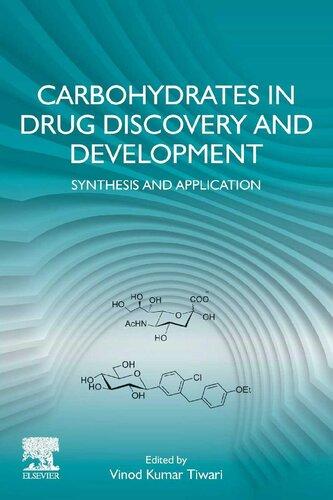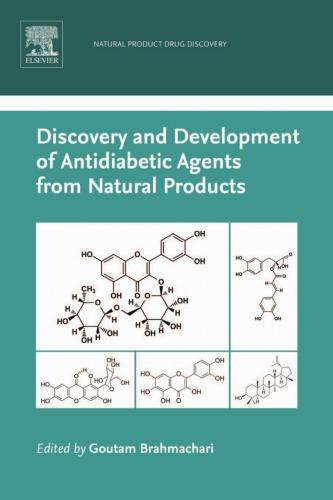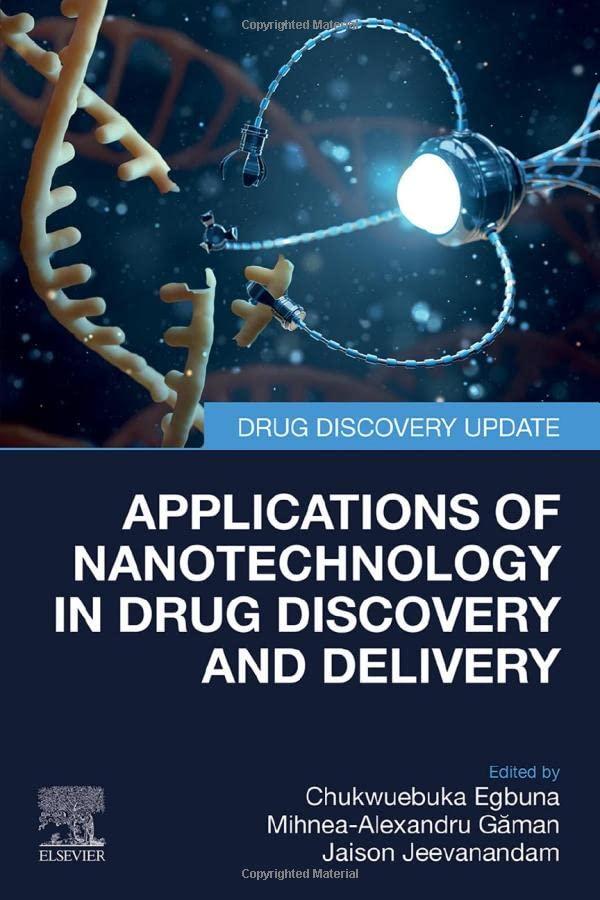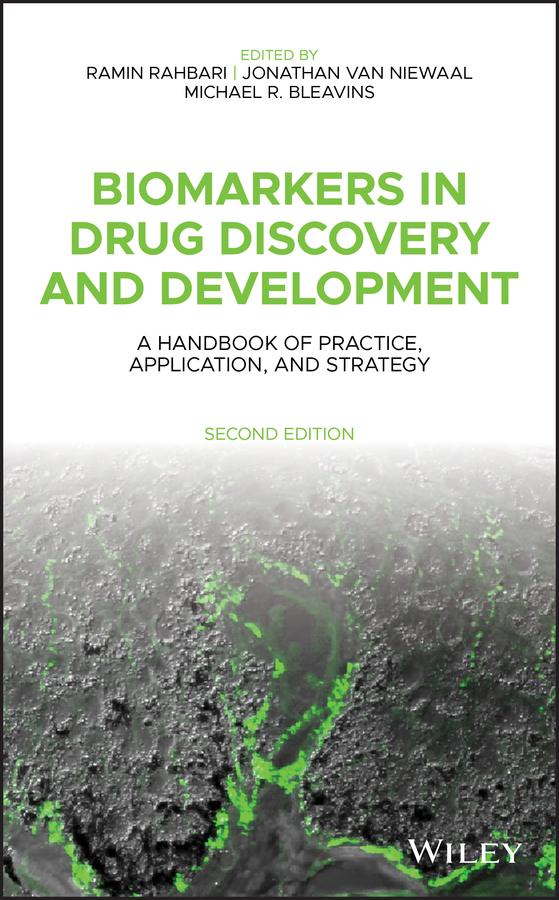BiomarkersinDrugDiscoveryand Development
AHandbookofPractice,Application,andStrategy
Editedby
RaminRahbari,MS,MBA
InnovativeScientificManagement
NewYork,NewYork
JonathanVanNiewaal,MBA
InnovativeScientificManagement
Woodbury,Minnesota
MichaelR.Bleavins,PhD,DABT
WhiteCrowInnovation
Dexter,Michigan
SecondEdition
Thiseditionfirstpublished2020
©2020JohnWiley&SonsInc.
EditionHistory
JohnWiley&SonsInc.(1e,2010)
Allrightsreserved.Nopartofthispublicationmaybereproduced,storedinaretrievalsystem,or transmitted,inanyformorbyanymeans,electronic,mechanical,photocopying,recordingor otherwise,exceptaspermittedbylaw.Adviceonhowtoobtainpermissiontoreusematerialfrom thistitleisavailableathttp://www.wiley.com/go/permissions.
TherightofRaminRahbari,JonathanVanNiewaal,andMichaelR.Bleavinstobeidentifiedasthe authorsoftheeditorialmaterialinthisworkhasbeenassertedinaccordancewithlaw.
RegisteredOffice
JohnWiley&Sons,Inc.,111RiverStreet,Hoboken,NJ07030,USA
EditorialOffice
111RiverStreet,Hoboken,NJ07030,USA
Fordetailsofourglobaleditorialoffices,customerservices,andmoreinformationaboutWiley productsvisitusatwww.wiley.com.
Wileyalsopublishesitsbooksinavarietyofelectronicformatsandbyprint-on-demand.Some contentthatappearsinstandardprintversionsofthisbookmaynotbeavailableinotherformats.
LimitofLiability/DisclaimerofWarranty
Inviewofongoingresearch,equipmentmodifications,changesingovernmentalregulations,and theconstantflowofinformationrelatingtotheuseofexperimentalreagents,equipment,and devices,thereaderisurgedtoreviewandevaluatetheinformationprovidedinthepackageinsert orinstructionsforeachchemical,pieceofequipment,reagent,ordevicefor,amongotherthings, anychangesintheinstructionsorindicationofusageandforaddedwarningsandprecautions. Whilethepublisherandauthorshaveusedtheirbesteffortsinpreparingthiswork,theymakeno representationsorwarrantieswithrespecttotheaccuracyorcompletenessofthecontentsofthis workandspecificallydisclaimallwarranties,includingwithoutlimitationanyimpliedwarranties ofmerchantabilityorfitnessforaparticularpurpose.Nowarrantymaybecreatedorextendedby salesrepresentatives,writtensalesmaterialsorpromotionalstatementsforthiswork.Thefact thatanorganization,website,orproductisreferredtointhisworkasacitationand/orpotential sourceoffurtherinformationdoesnotmeanthatthepublisherandauthorsendorsethe informationorservicestheorganization,website,orproductmayprovideorrecommendationsit maymake.Thisworkissoldwiththeunderstandingthatthepublisherisnotengagedin renderingprofessionalservices.Theadviceandstrategiescontainedhereinmaynotbesuitable foryoursituation.Youshouldconsultwithaspecialistwhereappropriate.Further,readersshould beawarethatwebsiteslistedinthisworkmayhavechangedordisappearedbetweenwhenthis workwaswrittenandwhenitisread.Neitherthepublishernorauthorsshallbeliableforanyloss ofprofitoranyothercommercialdamages,includingbutnotlimitedtospecial,incidental, consequential,orotherdamages.
LibraryofCongressCataloging-in-PublicationDataisavailableforthistitle HardbackISBN:9781119187509
Coverimage:CourtesyofRaminRahbari CoverdesignbyWiley
Setin10/12ptWarnockProbySPiGlobal,Chennai,India PrintedintheUnitedStatesofAmerica 10987654321
Contents
ListofContributors vii
Preface xiii
PartIBiomarkersandTheirRoleinDrugDevelopment 1
1BiomarkersAreNotNew 3 IanDews
2Biomarkers:FacingtheChallengesattheCrossroadsof ResearchandHealthCare 15 GregoryJ.Downing
3EnablingGo/NoGoDecisions 31 J.FredPritchardandM.LynnPritchard
4DevelopingaClinicalBiomarkerMethodwithExternal Resources:ACaseStudy 43 RossA.Fredenburg
PartIIIdentifyingNewBiomarkers:Technology Approaches 51
5ImagingasaLocalizedBiomarker:Opportunitiesand Challenges 53 JonathanB.Moody,PhilipS.Murphy,andEdwardP.Ficaro
6ImagingforEarlyClinicalDrugDevelopment:Integrating ImagingSciencewithDrugResearch 89
PhilipS.Murphy,MatsBergstrom,JonathanB.Moody,andEdwardP.Ficaro
7CirculatingMicroRNAsasBiomarkersinCardiovascularand PulmonaryVascularDisease:PromisesandChallenges 113 MirandaK.CulleyandStephenY.Chan
PartIIICharacterization,Validation,andUtilization 139
8CharacterizationandValidationofBiomarkersinDrug Development:RegulatoryPerspective 141 FedericoGoodsaid
9Fit-for-PurposeMethodValidationandAssaysforBiomarker CharacterizationtoSupportDrugDevelopment 149
JeanW.Lee,YulingWu,andJinWang
10ApplyingStatisticsAppropriatelyforYourBiomarker Application 177 MaryZacour
PartIVBiomarkersinDiscoveryandPreclinicalSafety 219
11QualificationofSafetyBiomarkersforApplicationtoEarly DrugDevelopment 221
WilliamB.MattesandFrankD.Sistare
12APathologist’sViewofDrugandBiomarker Development 233
RobertW.Dunstan
13DevelopmentofSerumCalciumandPhosphorusasSafety BiomarkersforDrug-InducedSystemicMineralization:Case StudywiththeMEKInhibitorPD0325901 255
AlanP.Brown
14NewMarkersofKidneyInjury 281
SvenA.Beushausen
PartVTranslatingfromPreclinicaltoClinicaland Back 307
15BiomarkersfromBenchtoBedsideand Back–Back-TranslationofClinicalStudiestoPreclinical Models 309
DamianO’Connell,ZakiShaikhibrahim,FrankKramer,andMatthiasOcker
16TranslationalMedicine–AParadigmShiftinModernDrug DiscoveryandDevelopment:TheRoleofBiomarkers 333 GioraZ.Feuerstein,SalvatoreAlesci,FrankL.Walsh,J.LynnRutkowski,and RobertR.RuffoloJr.
17ClinicalValidationandBiomarkerTranslation 347 Ji-YoungV.Kim,RaymondT.Ng,RobertBalshaw,PaulKeown,Robert McMaster,BruceMcManus,KarenLam,andScottJ.Tebbutt
18PredictingandAssessinganInflammatoryDiseaseandIts Complications:ExamplefromRheumatoidArthritis 365 ChristinaTrollmoandLarsKlareskog
19Validating InVitro ToxicityBiomarkersAgainstClinical Endpoints 379 CalvertLoudenandRuthA.Roberts
PartVIBiomarkersinClinicalTrials 389
20OpportunitiesandPitfallsAssociatedwithEarlyUtilizationof Biomarkers:ACaseStudyinAnticoagulant Development 391 KayA.Criswell
21IntegratingMolecularTestingintoClinicalApplications 409 AnthonyA.Killeen
PartVIIBigData,DataMining,andBiomarkers 421
22ITSupportingBiomarker-EnabledDrugDevelopment 423 MichaelHehenberger
23IdentifyingBiomarkerProfilesThroughtheEpidemiologic AnalysisofBigHealthCareData–ImplicationsforClinical ManagementandClinicalTrialDesign:ACaseStudyin AnemiaofChronicKidneyDisease 447
GregoryP.Fusco
24ComputationalBiologyApproachestoSupportBiomarker DiscoveryandDevelopment 469
BinLi,HyunjinShin,WilliamL.Trepicchio,andAndrewDorner
PartVIIILessonsLearned:PracticalAspectsofBiomarker Implementation 485
25BiomarkersinPharmaceuticalDevelopment:TheEssential RoleofProjectManagementandTeamwork 487
LenaKing,MalléJurima-Romet,andNitaIchhpurani
26NovelandTraditionalNonclinicalBiomarkerUtilizationinthe EstimationofPharmaceuticalTherapeuticIndices 505
BruceD.Car,BrianGemzik,andWilliamR.Foster
PartIXWhereAreWeHeadingandWhatDoWeReally Need? 515
27EthicsofBiomarkers:TheBordersofInvestigativeResearch, InformedConsent,andPatientProtection 517
SaraAssadian,MichaelBurgess,BreanneCrouch,KarenLam,andBruce McManus
28Anti-UnicornPrinciple:AppropriateBiomarkersDon’tNeed toBeRareorHardtoFind 537
MichaelR.BleavinsandRaminRahbari
29TranslationalBiomarkerImaging:Applications,Trends,and SuccessesTodayandTomorrow 553
PatrickMcConvilleandDeanneLister
Index 585
ListofContributors
SalvatoreAlesci TakedaPharmaceuticals
Cambridge,MA USA
SaraAssadian PROOFCentreofExcellence Vancouver,BC Canada and UniversityofBritishColumbia Vancouver,BritishColumbia Canada
RobertBalshaw PROOFCentreofExcellenceand BiomarkersinTransplantationTeam Vancouver,BC Canada
MatsBergstrom IndependentConsultant Uppsala Sweden
SvenA.Beushausen ZoeticPharmaceuticals
Amherst
NewYork,NY USA
MichaelR.Bleavins WhiteCrowInnovation Dexter,MI USA
AlanP.Brown NovartisInstitutesforBiomedical Research Cambridge,MA USA
MichaelBurgess UniversityofBritishColumbia Vancouver,BC Canada
BruceD.Car Bristol-MyersSquibbCo. Princeton,NJ USA
StephenY.Chan UniversityofPittsburghMedical Center Pittsburgh,PA USA
KayA.Criswell WestbrookBiomarker&PharmaceuticalConsulting,LLC Westbrook,CT USA
BreanneCrouch PROOFCentreofExcellence Vancouver,BC Canada and UniversityofBritishColumbia Vancouver,BritishColumbia Canada
MirandaK.Culley CenterforPulmonaryVascularBiologyandMedicine,PittsburghHeart, Lung,Blood,andVascularMedicine Institute UniversityofPittsburghSchoolof Medicine Pittsburgh,PA USA
IanDews EnvestiaLtd. Thame,Oxfordshire UK
AndrewDorner TakedaPharmaceuticals InternationalCo. Cambridge,MA USA
GregoryJ.Downing InnovationHorizons,LLC Washington,DC USA
RobertW.Dunstan Abbvie Worcester,MA USA
GioraZ.Feuerstein UnitedStatesDepartmentofDefense DefenseThreatReductionAgency FortBelvoir,VA USA
EdwardP.Ficaro INVIAMedicalImagingSolutions AnnArbor,MI USA
WilliamR.Foster Bristol-MyersSquibbCo. Princeton,NJ USA
RossA.Fredenburg AmathusTherapeutics,Inc. Cambridge,MA USA
GregoryP.Fusco Epividian,Inc. Chicago,IL USA
BrianGemzik Bristol-MyersSquibbCo. Princeton,NJ USA
FedericoGoodsaid RegulatoryPathfinders SanJuan PRUSA
MichaelHehenberger HMNanoMed Westport,CT USA
NitaIchhpurani InnovativeScientificManagement Toronto,ON Canada
MalleJurima-Romet Celerion Montreal,QC Canada
PaulKeown
PROOFCentreofExcellenceand BiomarkersinTransplantationTeam Vancouver,BC Canada
AnthonyA.Killeen UniversityofMinnesota Minneapolis,MN USA
Ji-YoungV.Kim
PROOFCentreofExcellenceand BiomarkersinTransplantationTeam Vancouver,BC Canada
LenaKing InnovativeScientificManagement Guelph,ON Canada
LarsKlareskog KarolinskaInstitute Stockholm Sweden
FrankKramer BayerAG Wuppertal Germany
KarenLam
PROOFCentreofExcellence Vancouver,BC Canada and UniversityofBritishColumbia Vancouver,BritishColumbia Canada
JeanW.Lee BioQualQuan Camarillo,CA USA
DeanneLister Invicro,aKonicaMinoltaCompany, SanDiego,CAandDepartmentof Radiology UniversityofCalifornia,SanDiego, MolecularImagingCenter, SanfordConsortiumforRegenerative Medicine
BinLi TakedaPharmaceuticalsInternationalCo. Cambridge,MA USA
XiaowuLiang ImmPORTTherapeutics Irvine California
CalvertLouden Johnson&JohnsonPharmaceuticals Raritan,NJ USA
WilliamB.Mattes NationalCenterforToxicological Research USFDA
Jefferson,AR USA
PatrickMcConville Invicro,aKonicaMinoltaCompany, SanDiego,CAandDepartmentof Radiology UniversityofCalifornia,SanDiego, MolecularImagingCenter, SanfordConsortiumforRegenerative Medicine
BruceMcManus
PROOFCentreofExcellence Vancouver,BC Canada
x ListofContributors and UniversityofBritishColumbia
Vancouver,BritishColumbia
Canada
RobertMcMaster
PROOFCentreofExcellenceand BiomarkersinTransplantationTeam
Vancouver,BC
Canada
JonathanB.Moody INVIAMedicalImagingSolutions
AnnArbor,MI USA
PhilipS.Murphy GlaxoSmithKlineResearchand Development Stevenage
UK
RaymondT.Ng
PROOFCentreofExcellenceand BiomarkersinTransplantationTeam
Vancouver,BC
Canada
MatthiasOcker BayerAG Germany Berlin and ChariteUniversityMedicine Berlin Germany
DamianO’Connell ExperimentalDrugDevelopment CentreA*STAR
Singapore
J.FredPritchard Celerion LincolnNebraska,NE USA
M.LynnPritchard BrantaBioscience,LLC Littleton,NC USA
RaminRahbari InnovativeScientificManagement NewYork,NY USA
RuthA.Roberts Apconix AlderleyEdge,Cheshire UK
RobertR.Ruffolo RuffoloConsulting SpringCity,PA USA
J.LynnRutkowski Ossianix Philadelphia,PA USA
ZakiShaikhibrahim BayerAG Germany Berlin HyunjinShin TakedaPharmaceuticals InternationalCo. Cambridge,MA USA
FrankD.Sistare MerckResearchLaboratories WestPoint,PA USA
ScottJ.Tebbutt PROOFCentreofExcellenceand BiomarkersinTransplantationTeam Vancouver,BC Canada
WilliamL.Trepicchio TakedaPharmaceuticals InternationalCo. Cambridge,MA USA
ChristinaTrollmo RochePharmaceuticals Stockholm Sweden
JinWang Amgen,Inc. ThousandOaks,CA USA
FrankL.Walsh WyethResearch Collegeville,PA USA
YulingWu MedImmune Gaithersburg,MD USA
MaryZacour BioZacConsulting Montreal,QC Canada
Preface
Sincethefirsteditionof BiomarkersinDrugDevelopment:AHandbookofPractice,Application,andStrategy waspublishedin2010,biomarkershavebecome evenmoresignificant,valuable,andimportantinthedecision-makingmultiplecriteriaforthedevelopmentofnewdrugs.Inparticular,previouslynovel biomarkersinnonclinicalstudieshavetransitionedintoclinicaltrials.Companiesandregulatoryagencieshavebecomemorecomfortablewiththeinclusion ofbiomarkersin exvivo experimentswithhumantissues/biofluidsorPhaseI trials,withmanyearlyclinicaltrialsnowincludingpatientsafteranadditional singleascendingdosestudyinhumanvolunteers.
Theuseofbiomarkertechnologiesandstrategiesinpharmaceuticaldevelopmentremainsthebasisfortranslationalmedicine,improvedpatientstratification,andidentificationofunderlyingcausesofdiseasesoncelumpedtogether basedprimarilyonsymptomatology.Theapprovalratesfornewdrugshavealso increasedrelativeto2010,atleastpartiallyduetojudicioususeofbiomarkers toidentifythebestcompounds,aswellasansweringtheregulators’questions morespecifically.Patients,regulatoryreviewers,andthepharmaceuticalindustryareseeingsafer,moreefficacious,andbetterunderstooddrugstotreatcomplexdiseases.Thechallengesofescalatingdrugdevelopmentcosts,increasingdurationofclinicaldevelopmenttimes,highratesofcompoundfailurein PhaseIIandIIIclinicaltrials,blockbusterdrugscomingoffpatent,andnovel butunproventargetsemergingfromdiscoveryallcontinuetomodifythearena. Thesefactorshavepressuredpharmaceuticalresearchdivisionstolookforways toreducedevelopmentcosts,makebetterandmoreinformeddecisionsearlier,reassesstraditionaltestingstrategies,andimplementnewtechnologiesto improvethedrugdiscoveryanddevelopmentprocesses.Biomarkersremain animportanttoolforgettingnewmedicinestopatientsandhelpingidentify moleculeswithunacceptableliabilitiesearlierintheprocess.
Biomarkershaveproventobevaluabledrugdevelopmenttoolsthatenhance targetvalidation,therebyhelpingbetterunderstandmechanismsofactionand enablingearlieridentificationofcompoundswiththehighestpotentialforefficacyinhumans.Ingenetherapy,useofanimalmodelsofdiseaseintoxicology
studiesfrequentlyallowsveryearlymonitoringofdisease-relatedbiomarkers thatareknowntobeimportantindiseasecauseandprogression,withthesame biomarkersmeasuredintheclinicaltrials.Thebiomarkerendpointscanbe essentialforeliminatingcompoundswithunacceptablesafetyrisksorlackof targetengagement,enablingtheconceptof“failfast,failearly,”andprovidingmoreaccurateorcompleteinformationregardingdrugperformanceand diseaseprogression.Atthesametimethatpharmaceuticalscientistsarefocusingonbiomarkersindrugdiscoveryanddevelopment,andclinicalinvestigatorsandhealthcarepractitionersareusingbiomarkersincreasinglyinmedical decision-makinganddiagnosis.Similarly,regulatoryagencieshaverecognized andembracedthevalueofbiomarkerstoguideregulatorydecision-making abouttargeting,drugsafety,andefficacy.RegulatoryagenciesintheUnited States,Europe,GreatBritain,Japan,andChinahavetakenleadershiprolesin encouragingbiomarkerinnovationintheindustryandcollaborationtoidentify,evaluate,andqualifynovelbiomarkers.Moreover,abiomarkerstrategy facilitatesthechoiceofacriticalpathtodifferentiateproductsinacompetitive marketplace.
Biomarkerscontinuetobeasignificantfocusofspecializedscientific meetingsandextensivemediacoverage.Thetargeteduseofbiomarkersalso ismoreprominentinscientificsocietymeetingpresentationstohighlight newtherapeutictargets,upstreamanddownstreamapplicationsrelevant toagivendisease,andascasestudiesdescribinghowdecision-makingand compoundselectionwereinfluenced.We,thecoeditors,feltthatupdating thefirsteditionof BiomarkersinDrugDevelopment:AHandbookofPractice, Application,andStrategy wastimely,aswasthecontinuedemphasison practicalaspectsofbiomarkeridentificationanduse,aswellastheirstrategic implementation,andessentialapplicationinimprovingdrugdevelopment approaches.Weeachhaveexperienceworkingwithbiomarkersindrug development,butwerecognizedthatthespecializedknowledgeofadiverse groupofexpertswasnecessarytocreatethetypeofcomprehensivebook thatisneeded.Therefore,contributionswereinvitedfromauthorswriting chaptersinthefirstedition,andotherswhoareequallyrenownedexperts intheirrespectivefields.Thecontributorsincludescientistsfromacademia, researchhospitals,biotechnologyandpharmaceuticalcompanies,contract researchorganizations,andconsultingfirmsandthosefromtheFDA.This secondeditionalsohasincludedmorecoverageoninformationtechnology andcomputationalinfluencesinbiomarkerdevelopmentandapplication.The resultisabookthatwebelievewillappealbroadlytopharmaceuticalresearch scientists,clinicalandacademicinvestigators,regulatoryscientists,managers, students,andallotherprofessionalsengagedindrugdevelopmentwhoare interestedinfurtheringtheirknowledgeofbiomarkers.
Asdiscussedearlyinthebook,biomarkersarenotnew,yettheyalsoare continuouslyevolving.Theyhavebeenusedforhundredsofyearstohelp
physiciansdiagnoseandtreatdisease.Whatisnewisanexpansionfrom outcomebiomarkerstotargetandmechanisticbiomarkers;theavailability of“omics,”imaging,andothertechnologiesthatallowcollectionoflarge amountsofdataatthemolecular,tissue,andwhole-organismlevels;and theuseofdata-richbiomarkerinformationfor“translationalresearch,” fromthelaboratorybenchtotheclinicandback.Thepotentialandvalue fromtheclinicalobservationsbacktothebenchshouldnotbetakenlightly. Improvementsindatastorage,computationaltools,andmodelingabilities provideuswiththeinsightthroughtheprocessandtheabilitytoreverse mineevenverylargedatasets.Laterchaptersarededicatedtohighlighting severalimportanttechnologiesthataffectdrugdiscoveryanddevelopment, theconductofclinicaltrials,andthetreatmentofpatients.
Thebookcontinueswithinvitedleadersfromindustryandregulatory agenciestodiscussthequalificationofbiomarkerassaysinthefit-for-purpose process,includingperspectivesonthedevelopmentofdiagnostics.Theimportanceofstatisticscannotbeoverlooked,andthistopicisalsoprofiledwitha practicaloverviewofconcepts,commonmistakes,andhelpfultipstoensure crediblebiomarkersthatcanaddresstheirintendeduses.Specificcasestudies areusedtopresentinformationonconceptsandexamplesofutilizingbiomarkersindiscovery,preclinicalsafetyassessment,clinicaltrials,andtranslational medicine.Examplesaredrawnfromawiderangeoftarget-organtoxicities, therapeuticareas,andproducttypes.Itishopedthatbypresentingawide rangeofbiomarkerapplications,discussedbyknowledgeableandexperienced scientists,readerswilldevelopanappreciationofthescopeandbreadthof biomarkerknowledgeandfindexamplesthatwillhelpthemintheirownwork. Lessonslearnedandthepracticalaspectsofimplementingbiomarkersin drugdevelopmentprogramsareperhapsthemostcriticalmessagetoconvey. Manypharmaceuticalcompanieshavecreatedtranslationalresearchdivisions, andincreasingly,externalpartners,includingacademicandgovernment institutions,contractresearchorganizations,andspecialtylaboratories,are providingtechnologiesandservicestosupportbiomarkerprograms.Thisis changingthetraditionalorganizationalmodelswithinindustryandpaving thewaytowardgreatercollaborationacrosssectorsandevenamongcompanieswithinacompetitiveindustry.Perspectivesfromcontributingauthors representingseveralofthesedifferentsectorsarepresented.
Thebookconcludeswithaperspectiveonfuturetrendsandoutlookson development,includingincreasingcapabilitiesindataintegration,privacyconcerns,therealityofpersonalizedmedicine,andtheaddressingofethicalconcerns.Thefieldofbiomarkersindrugdevelopmentisevolvingrapidly,andthis bookpresentsasnapshotofsomeexcitingnewapproaches.Byutilizingthe bookasasourceofnewknowledge,ortoreinforceorintegrateexistingknowledge,wehopethatreaderswillgainagreaterunderstandingandappreciation
xvi Preface
ofthestrategyandapplicationofbiomarkersindrugdevelopmentandbecome moreeffectivedecision-makersandcontributorsintheirownorganizations.
WealsonotewithregretthepassingofDr.MalléJurima-Romet,ourcoeditor forthefirstedition.AlthoughMalléwasnotabletobepartofthesecondeditionofthebook,herspiritandcommitmenttothefieldofbiomarkersresides throughoutthebook.Shewasachampionofbiomarkersandinfluencedmany duringhercareer.
Ashehasformanyyears,Dr.FelixdelaIglesiaalsodirecteduswithadvice, commentary,andmentorship.Hiscoachingtoalwaysworkwithsoundscience, payattentiontotheliterature,notbeingafraidtogosomewherejustbecause nooneelsehasventuredintothatterritory,andtopushboundariesallresonate inwork.Thevalueofhisexperienceandcriticalcommentaryhaveenhanced thisbook.
July2019
RaminRahbari JonVanNiewaal MichaelR.Bleavins
PartI
BiomarkersandTheirRoleinDrugDevelopment
BiomarkersAreNotNew
IanDews
EnvestiaLtd.,Thame,Oxfordshire,UK
Introduction
Theword biomarker initsmedicalcontextisalittleover40yearsold.The firsteverusageofthistermwasbyKarpetsky,Humphrey,andLevyinthe April1977editionofthe JournaloftheNationalCancerInstitute,wherethey reportedthatthe“serumRNaselevel wasnotabiomarkereitherforthe presenceorextentoftheplasmacelltumor.”Fewnewwordshaveprovedso popular–arecentPubMedsearchlistsmorethan 810,676 publicationsthat useit! Partofthissuccesscanundoubtedlybeattributedtothefactthatthe wordgavealong-overduenametoaphenomenonthathasbeenaroundat leastsincetheseventhcenturybc,whenSushustra,the“fatherofAyurvedic surgery,”recordedthattheurineofpatientswithdiabetesattractedants becauseofitssweetness.However,althoughtheoriginsofbiomarkersare indeedancient,itisfairtopointoutthatthepaceofprogressoverthefirst 2500yearswassomewhatlessthanfrenetic.
Uroscopy
Becauseofitseasyavailabilityforinspection,urinewasformanycenturies thefocusofattention.Thefoundationofthe“science”ofuroscopyisgenerally attributedtoHippocrates(460–355bc)whohypothesizedthaturinewasa filtrateofthe“humors,”takenfromthebloodandfilteredthroughthekidneys, areasonablyaccuratedescription.Oneofhismoreastuteobservationswas thatbubblesonthesurfaceoftheurine(nowknowntobeduetoproteinuria)
BiomarkersinDrugDiscoveryandDevelopment:AHandbookofPractice,Application,andStrategy, SecondEdition.EditedbyRaminRahbari,JonathanVanNiewaal,andMichaelR.Bleavins. ©2020JohnWiley&Sons,Inc.Published2020byJohnWiley&Sons,Inc.
wereasignoflong-termkidneydisease.Galen(ad129–200),themost influentialoftheancientGreco-Romanphysicians,soughttomakeuroscopy morespecificbut,inreality,addedlittletothesubjectbeyondtheweightofhis reputation,whichservedtohinderfurtherprogressinthisasinmanyother areasofmedicine.
Fivehundredyearslater,TheophilusProtospatharius,anotherGreekwriter, tookanimportantsteptowardsthemodernworldwhenheinvestigatedthe effectsofheatingurine,thusdevelopingtheworld’sfirstmedicallaboratory test.Hediscoveredthatheatingurineofpatientswithsymptomsofkidneydiseasecausedcloudiness(infact,theprecipitationofproteins).Inthesixteenth century,Paracelsus(1493–1541)inSwitzerlandusedvinegartobringoutthe samecloudiness(acid,likeheat,willprecipitateproteins).
Eventscontinuedtomovebothfarthernorthandclosertomodernitywhenin 1695FrederickDeckersofLeidenintheNetherlandsidentifiedthiscloudiness asresultingfromthepresenceofalbumin.Theloopwasfinallyclosedwhen RichardBright(1789–1858),aphysicianatGuy’sHospitalinLondon,made theassociationbetweenproteinuriaandautopsyfindingsofabnormalkidneys.
TheprogressfromHippocrates’sbubblestoBright’sdiseaserepresentsthe successfulsideofuroscopy,butotheraspectsofthesubjectnowstrikeusasa mixtureofcommonsenseandbizarresuperstition.Thetechniqueofcollecting urinewasthoughttobeofparamountimportanceforaccurateinterpretation. Intheeleventhcentury,IsmailofJurjaniinsistedonafull24-hourcollectionof urineinavesselthatwaslargeandclean(verysensible)andshapedlikeabladder,sothattheurinewouldnotloseits“form”(notatallsensible).Hisadvice tokeepthesampleoutofthesunandawayfromheatcontinues,however,to bewisecounseleventoday.
GillesdeCorbeil(1165–1213),physiciantoKingPhilipAugustusofFrance, recordeddifferencesinsedimentandcolorofurinewhichherelatedto20 differentbodilyconditions.Healsoinventedthematula,orjorden,aglassvesselthroughwhichthecolor,consistency,andclarityofthesamplecouldbe assessed.Shapedlikeabladderroundedatthebottomandmadeofthinclear glass,thematulawastobeheldupintheright(nottheleft)handforcareful inspectionagainstthelight.DeCorbeiltaughtthatdifferentareasofthebody wererepresentedbytheurineindifferentpartsofthematula.Theseconnections,whichbecameevermorecomplex,wererecordedonuroscopycharts thatwerepublishedonlyinLatin,thusensuringthattheknowledgeandits well-rewardeduseintreatingwealthypatientswereconfinedonlytoappropriatelyeducatedmen.Tofurtherthiseducation,deCorbeil,inhisroleasa professorattheMedicalSchoolofSalerno,setouthisownideasandthoseof theancientGreekandPersianwritersinaworkcalled PoemontheJudgment ofUrines,whichwassettomusicsuchthatmedicalstudentscouldmemorize itmoreeasily.Itremainedpopularforseveralcenturies.
BloodPressure
Oneofthefirstdeviationsfromtheusageofurineinthesearchformarkers offunctionanddiseasecamein1555withthepublicationofabookcalled Sphygmicaeartisiammilleducentosannosperditae&desiderataeLibriV bya physiciannamedJózefStru´s(betterknownbyhisLatinizedname,Iosephus Struthius)fromPoznán,Poland.Inthis366-pagework,Struthiusdescribed placingincreasingweightsontheskinoveranarteryuntilthepulsewasno longerabletolifttheload.Theweightneededtoachievethisgaveacrudemeasureofwhathecalled“thestrengthofthepulse”or,aswewouldcallittoday, bloodpressure.
Earlyattemptsatquantitativemeasurementofbloodpressurehadtobemade onanimalsratherthanonhumansubjectsbecauseoftheinvasivenessofthe technique.Thefirstrecordedsuccesswiththesetechniquesdatesfrom1733, whentheReverendStephenHales,aBritishveterinarysurgeon,insertedabrass pipeintoahorse’sarteryandconnectedthepipetoaglasstube.Halesobserved thebloodrisinginthetubeandconcludednotonlythattherisewasduetothe pressureofthebloodinthearterybutalsothattheheightoftherisewasa measureofthatpressure.
By1847,experimentaltechniquehadprogressedtothepointwhereitwas feasibletomeasurebloodpressureinhumans,albeitstillinvasively.CarlLudwiginsertedbrasscannulasdirectlyintoanarteryandconnectedthemvia furtherbrasspipeworktoaU-shapedmanometer.Anivoryfloatonthewater inthemanometerwasarrangedtomoveaquillagainstarotatingdrum,and theinstrumentwasknownasa kymograph (“wave-writer”inGreek).
Meanwhile,in1834,JulesHérissonhaddescribedhis sphygmomètre,which consistedofasteelcupcontainingmercury,coveredbyathinmembrane,with acalibratedglasstubeprojectingfromit.Themembranewasplacedoverthe skincoveringanartery,andthepressureinthearterycouldbegaugedfromthe movementsofthemercuryintotheglasstube.
Althoughminorimprovementsweresuggestedbyanumberofauthorsover thenextfewyears,creditfortheinventionofthetrue sphygmomanometer goestoSamuelSiegfriedKarlRittervonBasch,whoseoriginal1881model usedwaterinboththecuffandthemanometertube.Fiveyearslater,Scipione Riva-Rocciintroducedanimprovedversioninwhichaninflatablebagin thecuffwasconnectedtoamercurymanometer,butneitheroftheseearly machinesattractedwidespreadinterest.Onlyin1901,whenthefamous AmericansurgeonHarveyCushingbroughtbackoneofRiva-Rocci’smachines onhisreturnfromatriptoItalydidnoninvasivebloodpressuremeasurement reallytakeoff.
Sphygmomanometersofthelatenineteenthcenturyreliedonpalpationof thepulseandsocouldonlybeusedtodeterminesystolicbloodpressure.MeasurementofdiastolicpressureonlybecamepossiblewhenNikolaiKorotkoff
observedin1905thatcharacteristicsoundsweremadebytheconstrictionof thearteryatcertainpointsintheinflationanddeflationofthecuff.Thegreater accuracyallowedbyauscultationofthese Korotkoffsounds openedthewayfor themassiveexpansioninresearchworksonbloodpressurethatcharacterized thetwentiethcentury.
Imaging
Tophysicianskeentounderstandthehiddensecretsofthehumanbody,few ideashavebeenmoreappealingthanthedreamoflookingthroughtheskinto examinethetissuesbeneath.Themeansforachievingthisdidnotappearuntil alittleoveracenturyagoandthenverymuchbyaccident.Ontheeveningof8 November1895,WilhemRoentgen,aGermanphysicistworkingattheUniversityofWürzburg,noticedthatlightwascomingfromfluorescentmaterialinhis laboratoryandworkedoutthatthiswastheresultofradiationescapingfrom ashieldedgasdischargetubewithwhichhewasworking.Hewasfascinated bytheabilityofthisradiationtopassthroughapparentlyopaquematerialsand promptlysetaboutinvestigatingitspropertiesinmoredetail.Whileconductingexperimentswithdifferentthicknessesoftinfoil,henoticedthatiftherays passedthroughhishand,theycastashadowofthebones.
Havingseenthepotentialmedicalusesforhisnewdiscovery,Roentgen immediatelywroteapaperentitled“Onanewkindofray:apreliminary communication”fortheWürzburgPhysicalMedicalSociety,reprintsofwhich hesenttoanumberofeminentscientistswithwhomhewasfriendly.Oneof these,FranzExnerofVienna,wasthesonoftheeditorofthe ViennaPresse, andhencethenewswaspublishedquickly,firstinthatpaperandthenacross Europe.Whereasweareinclinedtobelievethatrapidpublicationisafeature oftheInternetage,theVictorianswerenoslouchesinthismatter,andby24 January1896,areprintoftheWürzburgpaperhadappearedintheLondon Electrician,amajorjournalabletobringdetailsoftheinventiontoamuch widertechnicalaudience.
Thespeedoftheresponsewasremarkable.Manyphysicslaboratoriesalready hadgasdischargetubes,and,withinamonth,physicistsinadozencountries werereproducingRoentgen’sfindings.EdwinFrostproducedanX-rayimage ofapatient’sfracturedwristforhisphysicianbrother,GilmonFrost,atDartmouthCollegeintheUnitedStates,whileatMcGillUniversityinMontreal, JohnCoxusedthenewraystolocateabulletinagunshotvictim’sleg.Similar resultswereobtainedincitiesasfarapartasCopenhagen,Prague,andRijekain Croatia.Inevitably,noteveryonewasinitiallyquitesoimpressed; TheLancet of 1February1896,expressedconsiderablesurprisethattheBelgianshaddecided tobringX-raysintopracticaluseinhospitalsthroughoutthecountry! Nevertheless,itwassoonclearthatamajornewdiagnostictoolhadbeenpresented
tothemedicalworld,andtherewaslittlesurprisewhenRoentgenreceiveda NobelPrizeinPhysicsin1901.
Meanwhile,inMarch1896,HenriBecquerel,ProfessorofPhysicsatthe MuséumNationald’HistoireNaturelleinParis,whileinvestigatingRoentgen’s work,wrappedafluorescentmineral,potassiumuranylsulfate,inphotographicplatesandblackmaterialinpreparationforanexperimentrequiring brightsunlight.However,aperiodofdullweatherintervened,and,priorto performingtheexperiment,Becquerelfoundthatthephotographicplates werefullyexposed.Thisledhimtowritethis:“Onemustconcludefromthese experimentsthatthephosphorescentsubstanceinquestionemitsrayswhich passthroughtheopaquepaperandreducesilversalts.”Becquerelreceived aNobelPrize,whichhesharedwithMarieandPierreCurie,in1903,butit wastobemanyyearsbeforetheuseofspontaneousradioactivityreached maturityinmedicalinvestigationinsuchapplicationsasisotopescanningand radioimmunoassay.
TheuseofafluoroscopicscreenonwhichX-raypicturesaretobeviewedwas implicitinRoentgen’soriginaldiscoveryandsoonbecamepartoftheroutine equipmentnotonlyofhospitalsbutevenofshoeshops,wherelargenumbers ofchildren’sshoefittingswerecarriedoutinthedaysbeforethetruedangersofradiationwereappreciated.However,thegreatestvalueofthereal-time viewingapproachemergedonlyfollowingtheintroductionofelectronicimage intensifiersbyPhilipsin1955.
WithinmonthsoftheintroductionofplanarX-rays,physicianswereaskingforatechniquethatwoulddemonstratethebodyinthreedimensions.This challengewastakenupbyseveralscientistsindifferentcountries,butbecause ofthedeeplyingrainedhabitofreviewingonlythenational,nottheinternational,literature,theyremainedignorantofeachother’sprogressformany years.
CarlMayer,aPolishphysician,firstsuggestedtheideaoftomography in1914.André-Edmund-MarieBocageinFrance,GustavGrossmannin Germany,andAllesandroVallebonainItalyalldevelopedtheideafurtherand builttheirownequipment.GeorgeZiedsesdesPlantesintheNetherlands pulledallthesestrandstogetherinthe1930sandisgenerallyconsideredthe founderofconventionaltomography.
Furtherprogresshadtowaitforthedevelopmentofpowerfulcomputers, anditwasnotuntil1972thatGodfreyHounsfield,anengineeratEMI (EMIRecordsLtd.,aBritishTransnationalconglomerate),designedthefirst computer-assistedtomographicdevice,theEMIscanner,installedatAtkinson MorleyHospital,London,anachievementforwhichhereceivedbothaNobel Prizeandaknighthood.
ParallelwiththeseadvancesinX-rayimagingwereongoingattempts tomakesimilaruseofthespontaneousradioactivitydiscoveredbyBecquerel.In1925,HerrmanBlumgartandOttoYensmadethefirstuseof
radioactivityasabiomarkerwhentheyusedbismuth-214todeterminethe arm-to-armcirculationtimeinpatients.Sodium-24,thefirstartificially createdbiomarkerradioisotope,wasusedbyJosephHamiltontoinvestigate electrolytemetabolismin1937.
UnlikeX-rays,however,radiationfromisotopesweakenoughtobesafewas notpowerfulenoughtocreateanimagemerelybylettingitfallonaphotographicplate.ThisproblemwassolvedwhenHalAngeroftheUniversityof California,buildingontheefficient γ-raycapturesystemusinglargeflatcrystalsofsodiumiodidedopedwiththalliumdevelopedbyRobertHofstadterin 1948,constructedthefirstgammacamerain1957.
Thedesireforthree-dimensionalimagesthatledtotomographywith X-raysalsoinfluencedradioisotopeimaginganddrovethedevelopment ofsingle-photon-emissioncomputedtomography(SPECT)byDavidKuhl andRoyEdwardsin1968.Positron-emissiontomography(PET)alsobuilds imagesbydetectingenergygivenoffbydecayingradioactiveisotopesinthe formofpositronsthatcollidewithelectronsandproduce γ-raysthatshoot offinnearlyoppositedirections.Thecollisionscanbelocatedinspaceby interpretingthepathsofthe γ-rays,andthisinformationisthenconverted intoathree-dimensionalimageslice.ThefirstPETcameraforhumanstudies wasbuiltbyEdwardHoffman,MichaelTer-Pogossian,andMichaelPhelpsin 1973atWashingtonUniversity.Thefirstwhole-bodyPETscannerappearedin 1977.
Radiation,whetherfromX-raytubesorfromradioisotopes,cametobe recognizedashavingdangersbothforthepatientandforpersonneloperating theequipment,andeffortsweremadetodiscovermediathatwouldproduce imageswithoutthesedangers.Inthelate1940s,GeorgeLudwig,ajunior lieutenantattheNavalMedicalResearchInstituteinBethseda,Maryland, undertookexperimentsusingindustrialultrasonicflawdetectionequipment todeterminetheacousticimpedanceofvarioustissues,includinghuman gallstonessurgicallyimplantedintothegallbladdersofdogs.Hisobservations weredetailedina30-pageprojectreporttotheNavalMedicalResearch Institutedated16June1949,nowconsideredthefirstreportofitskindonthe diagnosticuseofultrasound.However,asubstantialportionofLudwig’swork wasconsideredclassifiedinformationbytheNavyandwasnotpublishedin medicaljournals.
Civilianresearchintowhatbecamethetwobiggestareasofearlyultrasonic diagnosis–cardiologyandobstetrics–beganinSwedenandScotland, respectively,bothmakinguseofgadgetryinitiallydesignedforshipbuilding. In1953,IngeEdler,acardiologistatLundUniversity,collaboratedwithCarl HellmuthHertz,agraduatestudentinthedepartmentofnuclearphysicswho wasfamiliarwithusingultrasonicreflectoscopesfornondestructivematerials testing,andtogethertheydevelopedtheideaofusingthismethodinthefield ofmedicine.Theymadethefirstsuccessfulmeasurementofheartactivityon
9 29October1953,usingadeviceborrowedfromKockums,aMalmöshipyard. On16Decemberofthesameyear,themethodwasusedtogenerateanecho encephalogram.EdlerandHertzpublishedtheirfindingsin1954.
Ataroundthesametime,IanDonaldoftheGlasgowRoyalMaternityHospitalstruckuparelationshipwithboilermakersBabcock&WilcoxinRenfrew, whereheusedtheirindustrialultrasoundequipmenttoconductexperiments assessingtheultrasoniccharacteristicsofvarious invitro preparations.With fellowobstetricianJohnMacVicarandmedicalphysicistTomBrown,Donald refinedtheequipmenttothepointwhereitcouldbeusedsuccessfullyonlive volunteerpatients.Thesefindingswerereportedin TheLancet on7June1958, as“Investigationofabdominalmassesbypulsedultrasound.”
Nuclearmagneticresonance(NMR)inmoleculeswasfirstdescribedby IsidorRabiin1938.HisworkwasfollowedupeightyearslaterbyFelixBloch andEdwardMillsPurcell,who,workingindependently,noticedthatmagnetic nucleisuchashydrogenandphosphorus,whenplacedinamagneticfieldof aspecificstrength,absorbradio-frequencyenergy,asituationdescribedas being“inresonance.”
Forthenext20years,NMRfoundpurelyphysicalapplicationsinchemistry andphysics,anditwasnotuntil1971thatRaymondDamadianshowedthat thenuclearmagneticrelaxationtimesofdifferenttissues,especiallytumors, differed,thusraisingthepossibilityofusingthetechniquetodetectdisease. Magneticresonanceimaging(MRI)wasfirstdemonstratedonsmalltesttube samplesin1973byPaulLauterbur,andin1975RichardErnstproposedusing phaseandfrequencyencodingandtheFouriertransform,thetechniquethat stillformsthebasisofMRI.
Thefirstcommercialnuclearmagneticimagingscannerallowingimaging ofthebodyappearedin1980usingErnst’stechnique,whichallowedasingle imagetobeacquiredinapproximatelyfiveminutes.By1986,theimagingtime wasreducedtoaboutfivesecondswithoutcompromisingonimagequality.In thesameyear,theNMRmicroscopewasdeveloped,whichallowedapproximately10-mmresolutiononapproximately1-cmsamples.In1993,functional magneticresonanceimaging(fMRI)wasdeveloped,thuspermittingthemappingoffunctioninvariousregionsofthebrain.
Electrocardiography
Roentgen’sdiscoveryofX-raysgrewoutofthedetailedinvestigationof electricitythatwasacorescientificconcernofthenineteenthcentury,andit islittlesurprisethatinvestigatorsalsotookakeeninterestintheelectricity generatedbythehumanbodyitself.ForemostamongthesewasWillem Einthoven.Beforehisdays,althoughitwasknownthatthebodyproduced electricalcurrents,thetechnologywasinadequatetomeasureorrecord
themwithanysortofaccuracy.Startingin1901,Einthoven,aprofessorat theUniversityofLeiden,conductedaseriesofexperimentsusingastring galvanometer.Inhisdevice,electriccurrentspickedupfromelectrodeson thepatient’sskinpassedthroughathinfilamentrunningbetweenverystrong electromagnets.Theinteractionoftheelectricandmagneticfieldscausedthe filamentor“string”tomove,andthiswasdetectedbyusingalighttocasta shadowofthemovingstringontoamovingrollofphotographicpaper.
Itwasnot,atfirst,aneasytechnique.Theapparatusweighed600lb,including thewatercirculationsystemessentialforcoolingtheelectromagnets,andwas operatedbyateamoffivetechnicians.Overthenexttwodecades,Einthoven graduallyrefinedhismachineandusedittoestablishtheelectro-cardiographic (ECG)featuresofmanydifferentheartconditions,workthatwaseventually recognizedwithaNobelPrizein1924.
AstheECGbecamearoutinepartofmedicalinvestigations,itwasrealized thatasystemthatgaveonlya“snapshot”ofafewsecondsoftheheart’sactivity couldbeunhelpfulorevenmisleadingintheinvestigationofintermittentconditionssuchasarrhythmias.ThisproblemwasaddressedbyNormanHolter,an Americanbiophysicist,whocreatedhisfirstsuitcase-sized“ambulatory”monitorasearlyas1949,butwhosetechniqueisdatedinmanysourcestothemajor paperthathepublishedonthesubjectin1957,andotherauthorsciteaneven later,1961publication.
Hematology
Thescientificexaminationofbloodinordertolearnmoreaboutthehealth ofthepatientcanbedatedto1642,whenAnthonyvanLeeuwenhoekfirst observedbloodcellsthroughhisnewlyinventedmicroscope.Progresswasat firstslow,anditwasnotuntil1770thatleucocyteswerediscoveredbyWilliam Hewson,anEnglishsurgeon,whoalsoobservedthatredcellswereflatrather thanspherical,ashadearlierbeensupposed.
Associationofbloodcellcountswithclinicalillnessdependedonthe developmentofatechnicalmethodbywhichbloodcellscouldbecounted.In 1852,KarlVierordtattheUniversityofTübingendevelopedsuchatechnique, which,althoughtootediousforroutineuse,wasusedbyoneofhisstudents, H.Welcher,tocountredbloodcellsinapatientwith“chlorosis”(anoldword forwhatisprobablyourmoderniron-deficiencyanemia).Hefound,in1854, thatananemicpatienthadsignificantlyfewerredbloodcellsthandidanormal person.Platelets,thethirdmajorcellularconstituentofblood,wereidentified in1862byaGermananatomist,MaxSchultze.
Remarkably,allthesediscoveriesweremadewithoutthebenefitofcellstaining,anaidtomicroscopicvisualizationthatwasnotintroduceduntil1877in PaulEhrlich’sdoctoraldissertationattheUniversityofLeipzig.Themovement
ofbloodcellstudiesfromtheresearchlaboratorytoroutinesupportofpatient careneededafastandautomatictechniqueforseparatingandcountingcells, whichwaseventuallyprovidedbytheCoulterbrothers,WallaceandJoseph.In 1953theypatentedamachinethatdetectedthechangeinelectricalconductanceofasmallapertureasfluidcontainingcellswasdrawnthrough.Cells, beingnonconductingparticles,altertheeffectivecrosssectionoftheconductivechannelandsosignalboththeirpresenceandtheirsize.
Analternativetechnique,flowcytometry,wasalsodevelopedinstages betweenthelate1940sandtheearly1970s.FrankGuckeratNorthwestern Universitydevelopedamachineforcountingbacteriainalaminarstreamofair duringWorldWarIIandusedittotestgasmasks,theworksubsequentlybeing declassifiedandpublishedin1947.LouisKamentskyatIBMLaboratories andMackFulwylerattheLosAlamosNationalLaboratoryexperimented withfluidicswitchingandelectrostaticcelldetectors,respectively,andboth describedcellsortersin1965.Themodernapproachofdetectingcellsstained withfluorescentantibodieswasdevelopedin1972byLeonardHerzenbergand histeamatStanfordUniversity,whocoinedtheterm fluorescence-activated cellsorter (FACS).
BloodandUrineChemistry
Aswithhematology,realprogressinmeasuringthechemicalconstituentsof plasmadependedlargelyonthedevelopmentofthenecessarytechnology.Until suchtechniquesbecameavailable,however,ingenioususewasmadeofbioassays,developedinlivingorganismsorpreparationsmadefromthem,todetect andinsomecasesquantifycomplexmolecules.Agoodexampleofthisisthe detectionofhumanchorionicgonadotrophin(hCG)inurineasatestforpregnancy.SelmarAschheimandBernhardZondekinBerlin,whofirstisolatedthis hormonein1928,wentontodevisetheAschheim–Zondekpregnancytest, whichinvolvedfivedaysofinjectingurinefromthepatientrepeatedlyintoan infantilefemalemousewhichwassubsequentlykilledanddissected.ThefindingofovulationinthemouseindicatedthattheinjectedurinecontainedhCG andmeantthatthepatientwaspregnant.
Intheearly1940s,themousetestgavewaytothefrogtest,introducedby LancelotHogbeninEngland.Thiswasaconsiderableimprovement,inthat injectionofurineorserumfromapregnantwomanintothedorsallymphsac ofthefemaleAfricanclawedfrog(Xenopuslaevis)resultedinovulationwithin 4–12hours.Althoughthistestwasknowntogivearelativelyhighproportion offalsenegatives,itwasregardedasanoutstandingstepforwardindiagnosis. Onestoryfromthe1950srecountsthatwithregardtothepossiblepregnancyof aparticularpatient,“opinionsweresoughtfromanexperiencedgeneralpractitioner,aneminentgynecologist,andafrog;onlythefrogprovedtobecorrect.”
Pregnancytesting,andmanyother“biomarker”activities,subsequently movedfromout-and-outbioassaystothe“halfwayhouse”ofimmunological testsbasedonantibodiestothetestcompoundgeneratedinaconvenient speciesbutthenusedinan exvivo laboratorysetting,andin1960ahemagglutinationinhibitiontestforpregnancywasdevelopedbyLeifWideandCarl GemzellinUppsala.
Notallimmunereactionscanbemadetomodulatehemagglutination,anda problemwiththedevelopmentofimmunoassayswasfindingasimplewayto detectwhethertherelevantantibodyorantigenwaspresent.Oneanswerlay intheuseofradiolabeledreagents.Radioimmunoassaywasfirstdescribedina paperbyRosalynSussmanYalowandSolomonBersonpublishedin1960.
Radioactivityisdifficulttoworkwithbecauseofitssafetyconcerns,soan alternativewassought.Thiscamewiththerecognitionthatcertainenzymes (suchasABTSor3,3′ ,5,5′ -tetramethylbenzidine)whichreactwithappropriate substratestogiveacolorchangecouldbelinkedtoanappropriateantibody. ThislinkingprocesswasdevelopedindependentlybyStratisAvrameasandG.B. Pierce.Sinceitisnecessarytoremoveanyunboundantibodyorantigenby washing,theantibodyorantigenmustbefixedtothesurfaceofthecontainer, atechniquefirstpublishedbyWideandPorathin1966.
In1971,PeterPerlmannandEvaEngvallatStockholmUniversity,aswell asAntonSchuursandBaukevanWeemenintheNetherlands,independently publishedpapersthatsynthesizedthisknowledgeintomethodstoperform enzyme-linkedimmunosorbentassay(ELISA).
Afurthersteptowardphysicalmethodswasthedevelopmentofchromatography.Thewordwascoinedin1903bytheRussianbotanistMikhailTswettto describehisuseofaliquid–solidformofatechniquetoisolatevariousplant pigments.Hisworkwasnotwidelyacceptedatfirst,partlybecauseitwaspublishedinRussianandpartlybecauseArthurStollandRichardWillstätter,a muchbetter-knownSwiss–Germanresearchteam,wereunabletorepeatthe findings.
However,inthelate1930sandearly1940s,ArcherMartinandRichard SyngeattheWoolIndustriesResearchAssociationinLeedsdevisedaform ofliquid–liquidchromatographybysupportingthestationaryphase,inthis casewater,onsilicagelintheformofapackedbedandusedittoseparate someacetylaminoacidsderivedfromwool.Their1941paperincludeda recommendationthattheliquidmobilephasebereplacedwithasuitablegas thatwouldacceleratethetransferbetweenthetwophasesandprovidemore efficientseparation:thefirstmentionoftheconceptofgaschromatography. Infact,theirinsightwentevenfurther,inthattheyalsosuggestedtheuseof smallparticlesandhighpressurestoimprovetheseparation,thestartingpoint forhigh-performanceliquidchromatography(HPLC).
Gaschromatographywasthefirstoftheseconceptstobetakenforward. ErikaCremerworkingwithFritzPriorinGermanydevelopedgas–solid











